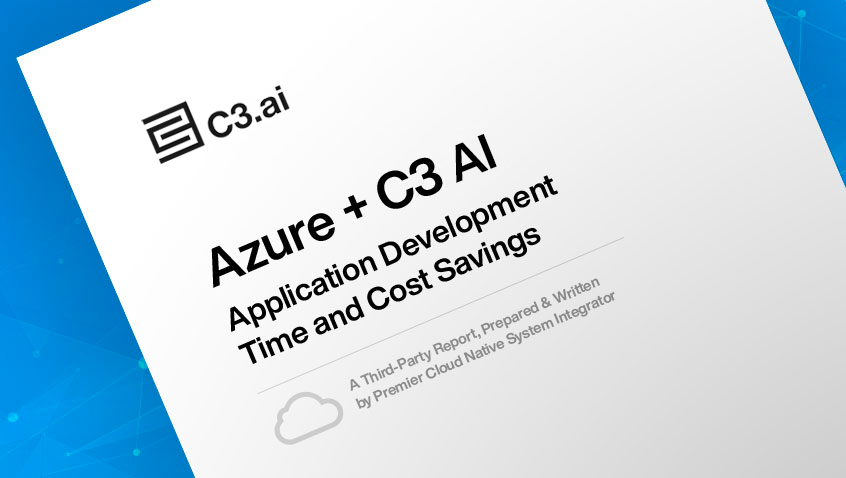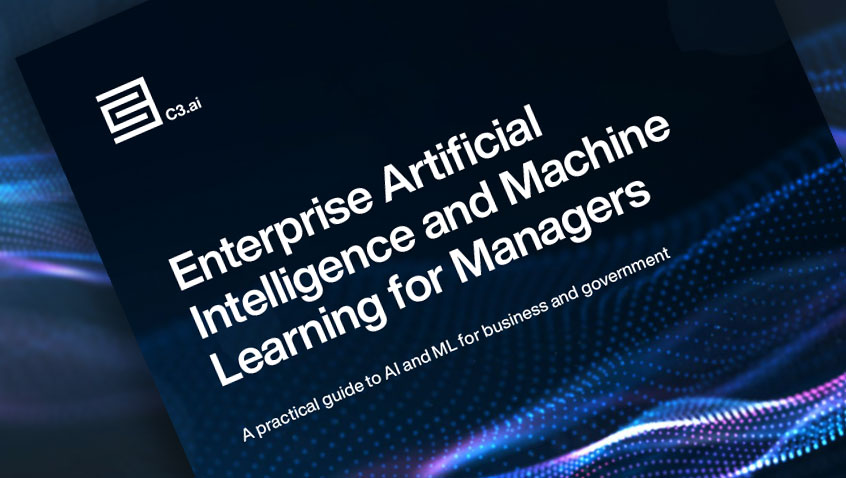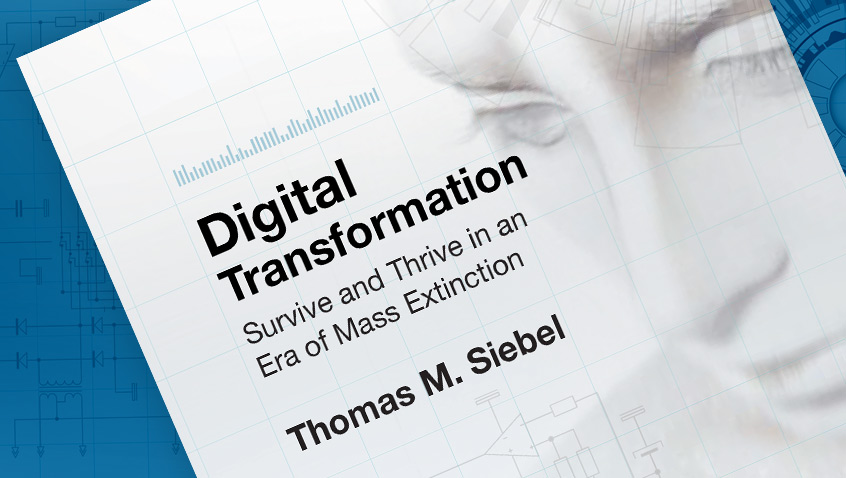- AI Software
- C3 AI Applications
- C3 AI Applications Overview
- C3 AI Anti-Money Laundering
- C3 AI Cash Management
- C3 AI Contested Logistics
- C3 AI CRM
- C3 AI Decision Advantage
- C3 AI Demand Forecasting
- C3 AI Energy Management
- C3 AI ESG
- C3 AI Health
- C3 AI Intelligence Analysis
- C3 AI Inventory Optimization
- C3 AI Process Optimization
- C3 AI Production Schedule Optimization
- C3 AI Property Appraisal
- C3 AI Readiness
- C3 AI Reliability
- C3 AI Smart Lending
- C3 AI Sourcing Optimization
- C3 AI Supply Network Risk
- C3 AI Turnaround Optimization
- C3 Generative AI Constituent Services
- C3 Law Enforcement
- C3 Agentic AI Platform
- C3 Generative AI
- Get Started with a C3 AI Pilot
- Industries
- Customers
- Events
- Resources
- Generative AI for Business
- Generative AI for Business
- C3 Generative AI: How Is It Unique?
- Reimagining the Enterprise with AI
- What To Consider When Using Generative AI
- Why Generative AI Is ‘Like the Internet Circa 1996’
- Can the Generative AI Hallucination Problem be Overcome?
- Transforming Healthcare Operations with Generative AI
- Data Avalanche to Strategic Advantage: Generative AI in Supply Chains
- Supply Chains for a Dangerous World: ‘Flexible, Resilient, Powered by AI’
- LLMs Pose Major Security Risks, Serving As ‘Attack Vectors’
- What Is Enterprise AI?
- Machine Learning
- Introduction
- What is Machine Learning?
- Tuning a Machine Learning Model
- Evaluating Model Performance
- Runtimes and Compute Requirements
- Selecting the Right AI/ML Problems
- Best Practices in Prototyping
- Best Practices in Ongoing Operations
- Building a Strong Team
- About the Author
- References
- Download eBook
- All Resources
- Publications
- Customer Viewpoints
- Blog
- Glossary
- Developer Portal
- Generative AI for Business
- News
- Company
- Contact Us
Glossary
- Artificial Intelligence
- AI Agents
- AI in Finance
- AI in Manufacturing
- Anomaly Detection
- Anti-Money Laundering
- Asset Performance Management
- Asset Reliability
- Demand Forecasting
- Digital Disruption
- Digital Transformation
- Digital Twin
- Elastic Cloud Computing
- Energy Management
- Enterprise AI
- Enterprise AI Platform
- Ethical AI
- Inventory Planning
- IoT Platform
- Know Your Customer (KYC)
- Machine Vision (Computer Vision)
- Model-Driven Architecture
- Multi-Cloud
- No Code
- Predictive Analytics
- Predictive Maintenance
- Process Optimization
- Production Scheduling
- Stochastic Optimization
- Supply Chain Management
- Type System
- Data Unification & Management
- Machine Learning (A to L)
- Artificial General Intelligence
- Bias
- Canonical Schema
- Canonical Transform
- Classification
- Classifier
- Classifier Performance
- Clustering
- Coefficient of Discrimination, R-Squared (R2)
- Convolutional Neural Network (CNN)
- Correlation
- Data Cleansing
- Data Labels
- Data Lineage
- Deep Learning
- Dimensionality Reduction
- Explainable AI
- F1 Score
- False Positive Rate
- Feature Engineering
- Feedback Loop
- Field Validation
- Gaussian Mixture Model (GMM)
- Generalized Linear Models
- Gradient-Boosted Decision Trees (GBDT)
- Features
- Ground Truth
- Holdout Data
- Hyperparameters
- Information Leakage
- LIME: Local Interpretable Model-Agnostic Explanations
- Linear Regression
- Loss Function
- Low-Dimensional Representation
- Machine Learning (M to Z)
- Mean Absolute Error
- Mean Absolute Percent Error
- Machine Learning Pipeline
- Model Drift
- Model Prototyping
- Model Training
- Model Validation
- Normalization
- Overfitting
- Precision
- Problem Tractability
- Random Forest
- Recall
- Receiver Operating Characteristic (ROC) Curve
- Regression Performance
- Regularization
- Reinforcement Learning
- Reporting Bias
- Ridge Regression
- Root Mean Square Error (RMSE)
- Selection Bias
- Shapley Values
- Supervised Machine Learning
- Tree-Based Models
- Underfitting
- Unsupervised Machine Learning
- XGBoost
Demand Forecasting
What is demand forecasting?
Demand forecasting is a supply chain process that analyzes historical data, sales projections, inventory management, and market trends to help businesses optimize operations, reduce costs, and meet customer demand. Accurate demand forecasting enables companies to balance supply and demand, minimize excess inventory, and improve productivity.
How is demand forecasting different from demand planning?
Demand planning is a comprehensive process that involves forecasting future customer demand, aligning inventory levels, and coordinating production schedules and resource allocation. The goal of demand planning is to ensure that a business can meet customer demand efficiently while minimizing costs and maximizing profitability. This process requires collaboration across different departments, including sales, marketing, finance, and supply chain management, to create a unified plan that aligns with the company’s strategic objectives.
Demand forecasting and demand planning are closely related, however they serve distinct purposes within the supply chain. Demand forecasting is the process of predicting future customer demand based on historical data, market trends, and other relevant factors. It serves as an important step in demand planning that provides the data needed to make informed decisions. Demand planning is a strategic process that uses insights from demand forecasting, along with other factors, including resource availability, supply chain disruptions, and business capabilities, to develop action plans ensuring the business can meet customer demand effectively. Demand forecasting is a crucial component of demand planning, providing the data-driven foundation upon which comprehensive demand plans are built.
How does demand forecasting fit into S&OP?
Sales and Operations Planning (S&OP) is a strategic part of the supply chain process that aims to achieve business objectives by aligning different operational functions such as sales, marketing, production, and finance. It enables departments to share common insights and align strategies, leading to more cohesive and effective decision-making. Demand forecasting plays a key role in S&OP by providing accurate future customer demand predictions. These predictions help create a demand plan, which is essential for the S&OP process, and ensure that the business can meet customer demand effectively while optimizing operational efficiency and minimizing costs.
Integrating demand forecasting into the S&OP process offers several key benefits. Demand forecasting enhances the accuracy of sales and production plans, reducing the risk of stockouts and excess inventory. Accurate demand forecasts enable businesses to align their production schedules with dynamic market conditions, ensuring product availability aligns with customer demand. Additionally, it improves cross-functional collaboration by providing a unified set of data and insights that all departments can use to make coordinated decisions. This integration enables the departments to develop a cohesive strategy that aligns with the organization’s overarching objectives. Furthermore, incorporating demand forecasting into S&OP enhances organizational agility and responsiveness, empowering businesses to adapt to fluctuations in market conditions and customer demand.
What is demand forecasting software?
Demand forecasting software leverages advanced technologies to generate precise demand forecasts. These solutions integrate and analyze a wide range of data sources, such as historical sales, market trends, and external factors, to predict future demand accurately. By automating and enhancing the forecasting process, demand forecasting software improves accuracy, reduces forecasting cycles, and increases overall efficiency in supply chain management.
Why is demand forecasting software important?
In today’s fast-paced and unpredictable market environment, accurate demand forecasting is crucial for maintaining a competitive edge. Demand forecasting software incorporates advanced technologies to provide precise forecasts, enabling businesses to respond swiftly to market changes and customer needs.
- Improved Forecast Accuracy: Demand forecasting software provides more accurate and reliable forecasts, helping businesses make better-informed decisions.
- Enhanced Service Levels: Accurate demand forecasts ensure that products are available when customers need them, leading to higher customer satisfaction.
- Reduced Stockouts and Excess Inventory: Effective demand forecasting minimizes the risk of stockouts and overstock situations, optimizing inventory levels and reducing costs.
- Cost Reduction: By streamlining production and procurement processes, demand forecasting software helps reduce operational costs and improve overall efficiency.
- Increased Visibility: Demand forecasting software unifies data from various sources, providing a comprehensive view of demand signals and improving supply chain visibility.
What is AI-driven demand forecasting?
AI-driven demand forecasting is the practice of using advanced machine learning (ML) and artificial intelligence (AI) techniques to optimize the accuracy and efficiency of demand forecasts. Integrating AI into demand forecasting software is critical for organizations to generate precise demand forecasts and improve supply chain management agility.
AI-driven demand forecasting accelerates an organization’s efforts to anticipate and meet customer demand. The approach continuously identifies deviations from predicted demand, provides AI-powered recommendations to improve performance, and enables demand forecasters to augment their expertise. AI-driven demand forecasting systems allow organizations to move beyond traditional manual forecasting to dynamic, predictive, and action-oriented demand management.
By implementing AI-driven demand forecasting software, organizations can:
- Utilize best-fit AI models to forecast across complex product hierarchy and SKU, customer, location combinations.
- Unify internal and external data to generate accurate, detailed, and adaptable demand forecasts.
- Quickly understand the drivers behind each forecast to improve decision-making.
- Adapt to changing demand signals, tracking them in near-real time across all channels and markets.
How does C3 AI enable AI-driven demand forecasting?
C3 AI provides a pre-built AI-powered demand forecasting application, C3 AI Demand Forecasting. C3 AI Demand Forecasting helps organizations to accurately forecast demand at any granularity, time horizon, and cadence. The application unifies disparate data such as order history, customer data, and marketing campaigns, and applies best-fit AI models to generate SKU, customer, and location-level forecasts. Benefits of C3 AI Demand Forecasting are:
- Accurate AI-Powered Forecasts: C3 AI Demand Forecasting provides precise forecasts for every forecasting subject, ensuring high accuracy at any granularity, time horizon, and cadence. This helps organizations reduce forecasting errors, leading to more reliable demand predictions.
- Operational Efficiency and Cost Reduction: By automating the forecasting process and integrating disparate data sources, C3 AI Demand Forecasting improves operational efficiency and reduces inventory costs. This streamlined approach allows businesses to optimize their supply chain operations and allocate resources more effectively.
- Reduced Stockouts and Improved Service Levels: C3 AI Demand Forecasting helps reduce stockout events, ensuring that products are available when customers need them. This leads to improved service levels and increased customer satisfaction, enhancing overall business performance.
- Enhanced Forecaster Productivity: C3 AI Demand Forecasting boosts demand forecaster efficiency by automating routine tasks and providing AI-generated forecasts that can trigger alerts. Forecasters can prioritize critical issues, reducing the overall demand forecasting cycle time and improving productivity.
- Adaptive and Flexible Forecasting: C3 AI Demand Forecasting automatically segments SKUs based on similar demand profiles and tunes ML models for each segment. This flexibility ensures accurate forecasts even in scenarios with limited or volatile data, adapting to various conditions.
- AI-Powered Evidence Package: To enable user trust and adoption, C3 AI Demand Forecasting supports each AI forecast with an evidence package that includes feature contributions, contextual data, and detailed reasoning.
Examples of customers who have successfully used C3 AI Demand Forecasting to improve demand forecasting include:
- Food Processing: A Fortune 100 food processing company deployed C3 AI Demand Forecasting application to uplift forecast accuracy across hundreds of SKUs.
- Computing Hardware Manufacturer: A global high-tech hardware leader deployed C3 AI Demand Forecasting application to optimize production and inventory levels to reduce cost.
- Agribusiness: A global agribusiness food manufacturer deployed C3 AI Demand Forecasting and C3 AI Production Schedule Optimization applications to improve demand forecast accuracy and reduce the time required to generate production schedules.
C3 AI Demand Forecasting helps organizations accurately forecast demand to optimize supply chain operations, improve service levels, and reduce stockouts, making it an invaluable tool for modern demand forecasting.
C3 AI applications are built on the C3 Agentic AI Platform, an end-to-end platform for developing enterprise AI applications. The C3 Agentic AI Platform offers a scalable and secure approach to enterprise AI, providing the necessary tools and capabilities to quickly design, develop, and operate advanced, industrial-scale AI applications.
The unique model-driven architecture of the C3 Agentic AI Platform allows organizations to build AI applications with less code, time, and effort compared to other methods. The platform features an end-to-end architecture that supports agentic AI services and capabilities such as generative AI integration and omni-modal data fusion, integrates with existing enterprise software systems, ingests into domain object models, applies out-of-the-box and configurable AI algorithms, and enables end-user interaction through intuitive, simple user interface applications.
C3 AI also provides a proven methodology and best practices for customer developers to configure, extend, and develop proprietary AI applications. C3 AI shares this methodology in a center of excellence collaboration model, delivering proven results as demonstrated by a decade of experience working with some of the world’s largest organizations on industrial scale use cases.



